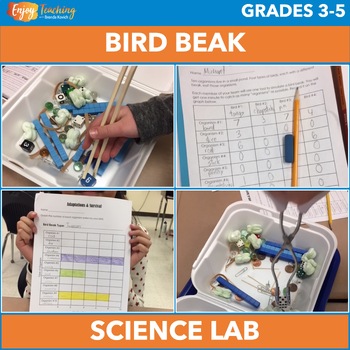Bird Beak Lab – Adaptations & Natural Selection Project – Fun Science Experiment
- PDF
- Easel Activity
What educators are saying
Also included in
- Looking for a challenging interdisciplinary unit? Developed for high ability students in fourth or fifth grade, this advanced project uses science, reading, research, and critical thinking to explore the nature of animal adaptation and its role in survival of birds. Open the previews to get a closerPrice $12.80Original Price $16.00Save $3.20
- Explore animal structures and functions with a project and a lab. Kids read about bird adaptations, answer questions, and create posters. They also experiment with beaks in a simulated environment. Your third, fourth, or fifth grade students will love these engaging interdisciplinary activities.OpePrice $8.00Original Price $10.00Save $2.00
- Looking for a thorough unit on plants and animals for your fourth or fifth grade class? This life science bundle scaffolds from cells to plants and animals. When you immerse your students in labs, activities, and reading passages, they truly understand how internal and external structures support suPrice $27.20Original Price $34.00Save $6.80
- Explore plant and animal structures with dozens of engaging activities that address NGSS 4-LS1-1. Fourth grade students examine how internal and external parts of flowering plants and birds support survival. Open the preview to take a closer look at the bundle.PLANTSSeeds, Germination, and DispersalPrice $20.80Original Price $26.00Save $5.20
- Seven engaging science modules address fourth grade life science standards for 33 states (NGSS and 13 others). Curriculum units include hands-on activities and projects; labs, stations, and experiments; STEM challenges; inquiry; and more. The following states and Washington, D.C. have adopted Next GPrice $24.80Original Price $31.00Save $6.20
- 23 engaging science modules address fourth grade science standards for 30 states (NGSS and 10 others). This full year of curriculum units includes hands-on activities, experiments, engineering design, and more.Open the previews to take a look at the standards-based units.The following states and WasPrice $97.20Original Price $121.50Save $24.30
- 25 engaging science modules address all new fourth grade Indiana Academic Standards for Science. A full year of curriculum units includes hands-on activities, experiments, engineering design, and more.This bundle addresses the intent of each standard and provides a variety of approaches to keep learPrice $105.20Original Price $131.50Save $26.30
- 22 engaging science modules address fourth grade Utah science standards. A full year of curriculum units includes hands-on activities; labs, stations, and experiments; STEM challenges; inquiry; and more.Created by a National Board Certified Teacher who taught fourth grade for many years, this bundlePrice $85.20Original Price $106.50Save $21.30
Description
In this science lab, kids simulate bird beak adaptations. They pick up organisms, record number caught, organize data, and answer questions. It’s a fun and educational natural selection experiment!
Open the preview to take a closer look at parts of the project.
Bird Beak Lab
This seriously fun science experiment illustrates why certain animals survive better in specific ecosystems.
Kids encounter an “ecosystem.” (It’s really just a container with ten sets of ten small items that represent organisms.
In groups of four, they use utensils to simulate different bird beaks. Each child uses one “beak” (tweezers, chopsticks, binder clip, tongs, etc.) to lift as many items as possible from the “ecosystem.” (Materials are returned to the box after each turn.)
Results are organized in tables and graphs. Each child records all group data on a table. They organize their own data in a bar graph.
Finally, students answer questions regarding animal adaptations and natural selection.
Optional Exploration of Science Practices
To reinforce elements of experimental design, add these activities to your bird beak lab.
First, discuss the fair test. A page of talking points will help you explain independent, controlled, and dependent variables, as well as the importance of measurement. Three anchor charts provide support.
Second, ask students to list steps in the scientific method on a lab sheet. They will fill in the question, hypothesis, independent variable (variable), controlled variables (controls or constants), dependent variables (results), and conclusion. Additionally, they’ll list measuring tools used in this experiment.
Third, a set of science discussion questions culminates the project. Since these questions are generic, you can use them for any experiment.
This bird beak lab requires a one-time set-up. After that, you can use the materials over and over – and even share with other classes.
- Look around your classroom and find items for the “ecosystem.” You’ll need ten sets of ten items.
- Each should have a different size, shape, and texture. Some, like the rubber band segments, could be related to a specific organism (worms!)
- Store the items in containers with lids. I used carry-out containers, but other teachers have used plastic bags, shoe boxes, etc.
Two options are included: printable and digital.
- Easel Activities
Your third, fourth, or fifth grade students will love it – and you will too!
- This hands-on lab is active, engaging, and fun.
- Activities address the intent of your standards. For example, if you teach NGSS 3-LS4-2 and 3-LS4-3, your students will learn how variations in characteristics provide advantages in survival and certain organisms survive better in specific habitats (natural selection). For NGSS 4-LS1-1, kids explore how animals’ external structures function to support survival.
- Furthermore, you can tie in important science practices in the fair test, or scientific method.
Looking for more? Check out the bundle, which also includes a set of bird adaptation reading passages.
Enjoy teaching!
Brenda Kovich














